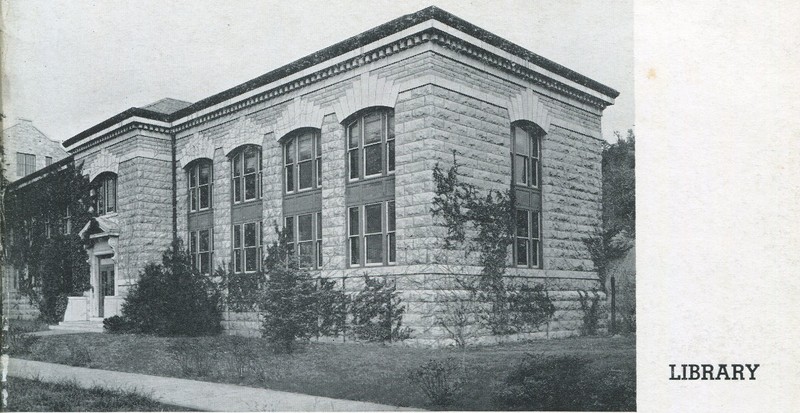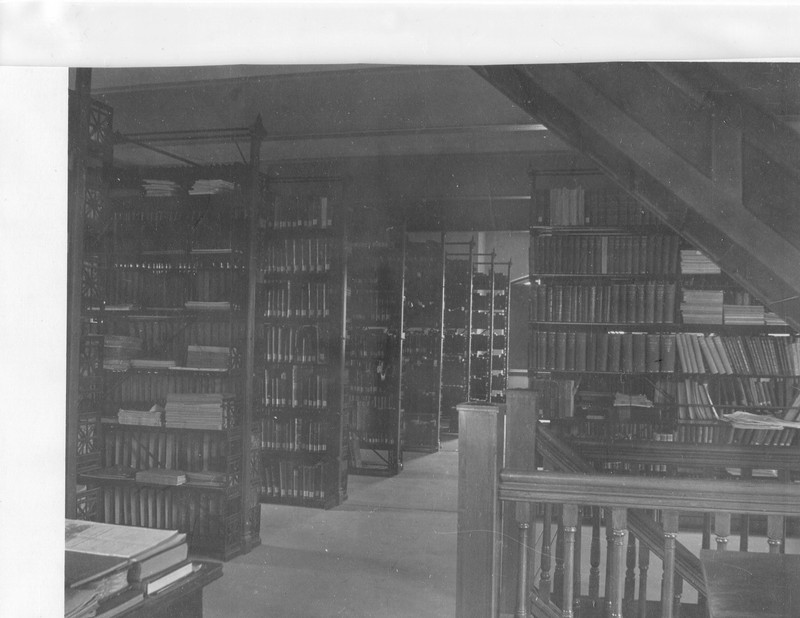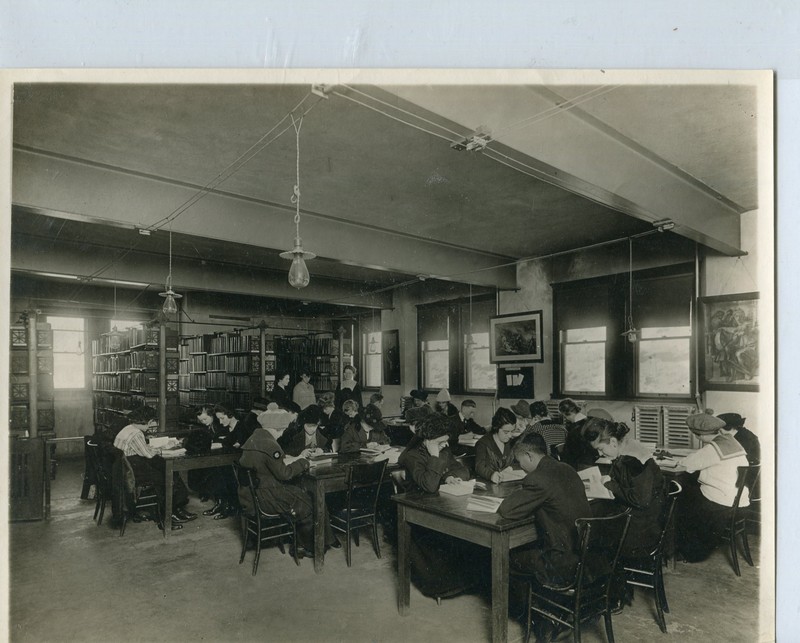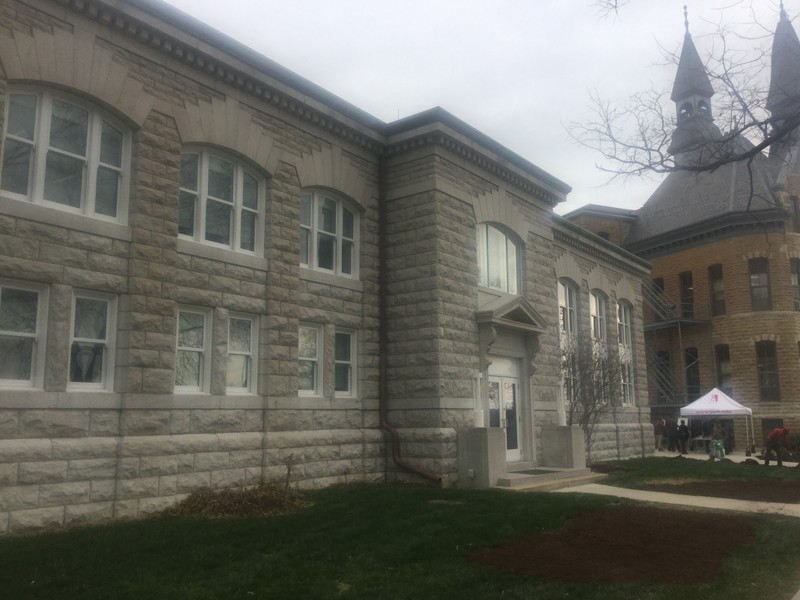Norrington Center
Introduction
Text-to-speech Audio
The building that would become Norrington Center started life as a library built with the help of the Carnegie Foundation in 1904. It has since seen an addition through a request to the Carnegie Foundation, a change in purpose, and a name change, but has since returned to being the Park University library. The renovation of Norrington Center received an Excellence Award in the Contemporary Design in a Historic Context Category from the Historic Kansas City organization at its Preservation Awards.
Images
Exterior of South reading room

The inside of the library stacks

One of the library's reading rooms

The front entrance to Norrington present day

The stained glass window in the foyer of Norrington.

The plaque commemorating the "Windows of Opportunity" campaign.

Backstory and Context
Text-to-speech Audio
Parks first libraries were not official school libraries but belonged to the the literary societies from which students were able to check out books, the first of which was the Cheevers Library in the original Copley Dorm. Books were mainly acquired by donation, and the literary societies would have competitions to raise books and donations to expand their reading rooms. In 1900 the books were moved into reading rooms in MacKay Hall, but they quickly ran out of space as more books were donated or purchased by the societies. Coming to the realization that they desperately needed a library Lowell McAfee, then Chairman of the Park College faculty, started correspondence with the Carnegie Foundation for a donation of $35,000 to build a library, this request was ultimately turned down. By 1904 Lowell had become the president of Park College and renewed his correspondence with the Carnegie Foundation in the hopes of receiving $35,000 for the library, they awarded Park $15,000 in 1905. In the hopes that they would acquire the remaining money from other sources the architects were instructed to construct the building "in such a way that future additions could be made without loss or marring of the architectural features of the building." The building was completed in 1908 with the help of student carpenters putting in window frames and student masons quarrying the stone, by 1915 the new President, Frederick Hawley set out to complete the library, but World War I and more important projects prevented it. 1921 was a turning point for the library Hawley was finally able to petition the Carnegie Fund Executive Committee, and received $50,000 to complete the library. Construction began in 1922, and it is doubtful if any work was done by the students, many structures of the original building, the roof, windows, and floors, were replaced to match the new construction. The library was completed the next year and furniture was moved in for occupancy in April. Extensive renovations have been done through the years including the expansion of the second floor and the modernization of the amenities, in 1977 donations were solicited by the Friends of the Park College Library for the repair of the stained glass window over the front door, the funds were gathered and the and the window was repaired with the addition of a alumni panel added to it. By 1988 excavation of the underground had been completed and the new McAfee Memorial Library was completed and the books and equipment of the Carnegie Library were moved to the new library. The building would then be used as an office building housing the offices of admissions and financial aid, until the instability of some areas of the underground caused the the library to be moved back above ground in the summer of 2016. 2009 saw the launching of the "Windows of Opportunity," when it was found that the windows were so poorly maintained that they desperately needed to be replaced, the campaign raised $336,500 from donations.
Elmer Norrington was born in Parkville, Missouri on February 11, 1898, and entered Park College in 1916. He was an active member of the Alumni Association and served on many councils raising money for the needs of the college. In 1956 he was selected as a member of the Board of Trustees and served for several terms and eventually was chosen as the chairman of the board. Norrington retired from the Board of Trustees in 1981 after serving for twenty years, but continued to give to Park until his death in 1983. As a last gift to the College, Elmer and his wife Rubye left $2.5 million to the college in an endowment fund. The official dedication of the Norrington Center was held on October 15, 1988, as part of the fall meeting of the Board of Trustees.
Elmer Norrington was born in Parkville, Missouri on February 11, 1898, and entered Park College in 1916. He was an active member of the Alumni Association and served on many councils raising money for the needs of the college. In 1956 he was selected as a member of the Board of Trustees and served for several terms and eventually was chosen as the chairman of the board. Norrington retired from the Board of Trustees in 1981 after serving for twenty years, but continued to give to Park until his death in 1983. As a last gift to the College, Elmer and his wife Rubye left $2.5 million to the college in an endowment fund. The official dedication of the Norrington Center was held on October 15, 1988, as part of the fall meeting of the Board of Trustees.
Sources
Norrington Records. The Park Building Collection. Fishburn Archives and Special Collections. Park University, Parkville, MO.
Elwess, Carolyn. Windows of Oppurtunity. Park University, 2009.
Beck, Bill. Fides et labor: 140 years of pioneering education: the story of Park University. Virginia Beach, VA: The Donning Company Publishers, 2015.
Elwess, Carolyn. Windows of Oppurtunity. Park University, 2009.
Beck, Bill. Fides et labor: 140 years of pioneering education: the story of Park University. Virginia Beach, VA: The Donning Company Publishers, 2015.
